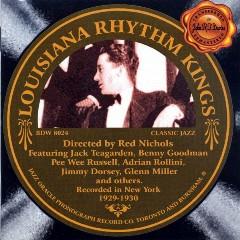Louisiana Rhythm Kings – Recorded In New York 1929-1930 (2002)
Louisiana Rhythm Kings – Recorded In New York 1929-1930 (2002)

1 Futuristic Rhythm 2:52 2 Out Where The Blues Begin 2:54 3 That's-A-Plenty 2:43 4 Ballin' The Jack 3:07 5 I'm Walking Through Clover (I'm Happy In Love) 2:47 6 That Da Da Strain 3:09 7 Basin Street Blues 3:16 8 Last Cent 3:00 9 Waiting At The End Of The Road 2:48 10 Little By Little 3:16 11 Marianne 2:33 12 Swanee 2:41 13 Squeeze Me 3:01 14 Oh, Lady Be Good! 3:18 15 Sweet Sue--Just You 3:05 16 Meanest Kind O' Blues 3:22 17 I Have To Have You 2:45 18 O'er The Billowy Sea 2:59 19 Lazy Daddy 2:42 20 Karavan 3:06 21 Pretty Baby -A 2:57 22 Pretty Baby -B 2:57 23 Tell Me 3:21 24 There's Egypt In Your Dreamy Eyes 2:49 Banjo, Guitar – Wes Vaughan (tracks: 12-24) Baritone Saxophone – Adrian Rollini (tracks: 12-24) Clarinet – Benny Goodman (tracks: 4-5), Pee Wee Russell (tracks: 6-8) Clarinet, Alto Saxophone – Jimmy Dorsey (tracks: 9-24) Clarinet, Leader, Arranged By – Red Nichols Clarinet, Tenor Saxophone – Fud Livingston (tracks: 1-3) Drums – Dave Tough (tracks: 6-11), Gene Krupa (tracks: 12-24), Vic Berton (tracks: 1-5) Mellophone – Dudley Fosdick (tracks: 1-3) Piano – Arthur Schutt (tracks: 1-5), Irving Brodsky (tracks: 9-11), Joe Sullivan (tracks: 6-8) Tenor Saxophone – Babe Russin (tracks: 12-24), Bud Freeman (tracks: 6-8) Trombone, Arranged By – Glenn Miller (tracks: 1-5, 9-24) Trombone, Vocals – Jack Teagarden (tracks: 6-8) Trumpet – Tommy Thunen (tracks: 9-24)
Like the Charleston Chasers, the Louisiana Rhythm Kings existed entirely as a studio recording ensemble. The time frame is even the same; both bands operated during those fascinatingly pivotal years of 1929 and 1930. The Louisiana Rhythm Kings were at first nothing more or less than a variable version of Red Nichols & His 5 Pennies, or in the case of the sessions recorded February 20 and April 23, 1929, the last vestiges of Red & Miff's Stompers. Miff Mole's trombone acted as the gravitational center of most every band he ever worked with, while Red was usually the next best thing to his idol, Bix Beiderbecke. Some of the players on the first three selections are holdovers from the Stompers sessions of several years earlier. Percussionist Vic Berton and pianist Arthur Schutt provide a rhythm background perfectly suited to those arrangements used in 1927 or even earlier. The wonderfully named Dudley Fosdick is heard augmenting the low end of the ensemble with a mellophone, softly and carefully interacting with Miff's trombone. What the first three tracks also offer are clear examples of the soloing abilities of Fud Livingston, who had distinguished himself as an arranger with Joe Venuti's band during the previous year. Fud was less adept at improvising than Benny Goodman, whose clarinet sounds refreshing by comparison during "Ballin' the Jack." But it is the session of June 11, 1929, that really rocks, largely because of Davey Tough's heavy-handed drumming during "That Da Da Strain." This sort of thundering on the drum kit was just beginning to find its way onto records after many years of percussive curtailment necessitated by limited recording technology. Also on "Da Da," Pee Wee Russell delivers one of his most eccentric clarinet solos, reinventing the time signature several times in rapid succession. "Last Cent" features Tough's press rolls and a swell tenor sax solo by Bud Freeman. "Basin Street" provides a nice example of Jack Teagarden's early singing style, although the song is slightly soured by a somewhat misogynistic lyric.
The recordings made on September 10, 1929, are a bit more perfunctory, probably because Davey Tough sounds more subdued. Maybe somebody told him to cool himself. Trombonist Glenn Miller and master clarinetist Jimmy Dorsey have also moved in. They stuck with the band throughout its next two sessions, which took place in January 1930. In addition to the two future big-band leaders already mentioned, Tommy Dorsey and Gene Krupa added their personalities to the proceedings. But some of the juiciest moments in the entire second half of this collection are directly attributable to the saxophonists. Fats Waller's "Squeeze Me" glows with solos by boot-boot-booting tenor man Babe Russin and bass saxophonist Adrian Rollini. These 1930 sides provide lots of kicking room for Russin, who is followed closely by Jimmy Dorsey's alto sax on "Karavan," a melody from out of the mind of early-'20s saxophone superstar Rudy Wiedoeft. Rollini and Glenn Miller both solo beautifully on "The Meanest Kind of Blues," while Tony Jackson's "Pretty Baby" becomes an elegant, majestic ritual for nine sympathetic souls. Outstanding chamber jazz from the end of one era and the beginning of another. ---arwulf arwulf, AllMusic Review
download (mp3 @320 kbs):








